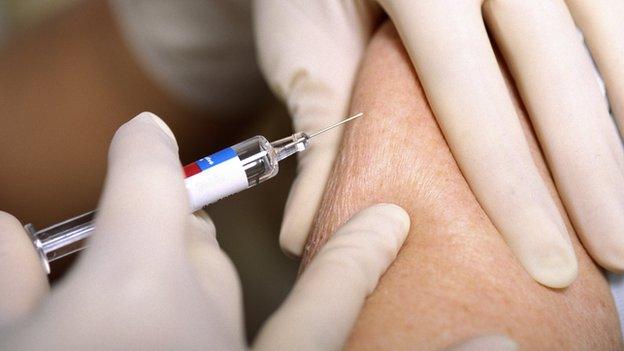Last year's flu vaccine was much better than we thought
- Published
- comments

Last winter's flu vaccine did much better than we first thought at fighting the disease and saving lives. The results were still not great and the overall death rate over the winter among older people in particular was high this year, but vaccination appears to have helped much more than previously estimated.
In a normal year, you would expect the vaccine to reduce the risk of contracting flu by about half. Back in February, I reported how the first estimates were that the vaccine was reducing it by just 3.4% - what looked like a very poor result.
That estimate - published in a European epidemiology journal, external - was driven by what seemed to be a particular difficulty with the H3N2 strain of the virus, a flu form which is hard on the elderly. The vaccine had no discernible effect against that subtype.
But I also cautioned: "The vaccine may be a little better than it now looks against H3N2 too - the confidence intervals on the effects of the vaccine are quite wide. It might turn out to be better than it looks. Let's hope." Happily, that hope has materialised - the final effectiveness rate is now estimated at 34%.
This was driven by a big change in the final analysis, which was posted in the same journal last week, external, and which put the final tally for effectiveness against H3N2 at 29.3%. Still not great - but an important intervention and a serious life-saver.
This raises two questions: why is the effectiveness low, and why did the estimates shift so much?
The flu problem
Flu is a lethal disease - and awkward, too. Vaccines need to match the precise subtypes of flu in circulation. So each year, a global analysis of flu types is produced by the World Health Organisation (WHO), who recommend a basket of types to vaccinate against.
But this needs to happen early: there are six companies who produce UK vaccines, and they have to make them between March and August. Then they turn to the southern hemisphere orders, so there's no capacity in the system at the moment to switch the vaccine quickly. Last year, we went with a type of H3N2 virus, a strain of H1N1 virus and a form of type B virus.

That gap in time creates a problem. First, the strains in circulation might not be the right ones by the time flu season starts in the autumn. Second, viruses go through something known as "antigenic drift" - even if we spot the right wave of virus, they can mutate as they reproduce so that they may stop matching up precisely against the vaccines we have prepared for them.
What happened here? We got the right sort of viruses, but they drifted. So we prepared for an H3N2 strain with the snappy branding of "A/Texas/50/2012". But the H3N2 virus in circulation had drifted away from that, and closer to a type known to its friends as "A/Switzerland/9715293/2013". That reduced its effectiveness.
A similar thing happened on the type B virus, too, although on a less significant scale. So why was the initial estimate was so different?
Random variation
Part of the reason why the overall effectiveness rose since February is that the H3N2 was more prevalent earlier. The B type virus, against which the vaccine did better, was more prevalent later. That does not explain, however, why the early estimates of effectiveness against H3N2 specifically got so much better.
This could be explained if the H3N2 strains in circulation shifted over the flu season back towards subtypes that match the vaccine. That, however, did not happen. The truth is much more prosaic: the paper says "random variation seems to provide the most likely explanation for our observed non-significant difference between [vaccine effectiveness] at the middle and the end of the season".
In short, the smallish 271-person sample of H3N2 patients studied in the first round of tests did not match results from the bigger sample of 629-patient sample that they now have. To be fair to them, the scientists made this explicit back in February: when they made their first estimate, they thought there was a 2.5% chance that it could end up being above 33%.
So what's the big picture on why the death rate was so high? In the past week, our estimates of the vaccine have moved from it being very ineffective to merely a bit sub par. But that still matters: as the paper notes: "the lower vaccine effectiveness seen this season is likely to have been a contributory factor to the relatively severe impact of influenza observed this year."
Meanwhile, H3N2 is a tough strain on older people, even when the vaccines are working well. The paper notes: "The last intense H3N2 season was in 2008/09, where even in a season with a moderately matched H3N2 vaccine component with high coverage in the elderly, significant levels of excess mortality in the [over-65] year olds was still seen".
And what should we take away from the whole saga?
First, take confidence intervals seriously. Second, take flu seriously. If you're eligible, get vaccinated. Even if the flu doesn't kill you, it could kill someone you pass it on to. Even a vaccine with 34% effectiveness is a lifesaver.